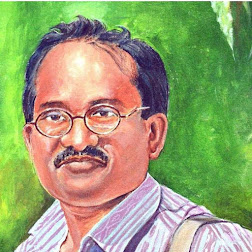 |
[while conferred with National Award by the than
President of India R.Venkatraman in 1987]
|
It takes a life time for anyone to be a master in any discipline of art, be it music, dance, fine-art or the craft. It is Manabodha Rana of Barpali who stood as a testimony to the ever changing times. He is attempting to recreate life out of earth itself. Manabodha Rana was born to a family of potters called kumbhar at Barpali. The vocation of this community is to make earthen pots and to sell them in the local market. Whereas Manabodha able to elevate himself to the higher grounds by creating earthen artefacts called terracotta. Due to poverty and the prevailing social standards of that time, he could able to attended school only up to 7th Standard. At age 13 he was inducted to the family vocation of pottery. He started rotating chak or the potters-wheel under the able stewardship of his father. He learnt to make objects of day today use like kuthul or guma (pots that are used to store water); handi (pots that are used to cook rice); patli (pots that are used to cook dal or pulses); telen (the plate used for covering handi or patli); taad (big containers used for storing rice); mrudung khol (body of the musical drums); dhupali and small lamps called deepa.
 |
| [ a large earthen pot for planting Tulsi shrub ] |
But once while making earthen toys for the Saptapuri Amavasya he was inspired to create life size figures of these toys. In this region during Saptapuri Amavasya earthen toys like hati (elephant), ghoda (horse), gai (cow), balada (bullock), maan/seer (measuring instrument for pulses) are used for offering puja. It is from where he diversified from being a potter to a terracotta artisan. As a potter he was knowing that his chak or the potter-wheel should move only clock-wise. And while rotating his wheel clock-wise, he able to revive the lost glory of Indian terracotta. He re-created miniature objects on roof-tiles. These objects include crow, parrot, dove, frog, scorpion, a mother monkey picking lice from the head of its baby and so on. He able to create a market for them among the elite class of the society in the metros and the international market. At present a roof-tile without these objects will cost you Rs.1 a piece at Barpali. Due to high labour input terracotta tiles are no more affordable, as compare to the cheaper and durable building materials like asbestos or the tin sheets.
 |
| [Miniature objects of birds, animals and reptiles on the roof tiles] |
 |
| [A close-up view of roof-tiles called khappar] |
His products are being exported to Japan, Denmark, Spain and France by Handicrafts and Handlooms Exports Corporation of India (HHEC).
 |
| [Lanthan a replica of a lantern run by kerosene] |
One of his works a 47 X 80 feets long terracotta mural is being showcased in one of the busiest metro rail stations of New Delhi at INA. It is an amalgamation of 58 rectangle pieces together to form a picturesque scene of the branch of a tree on which birds are chirping, while squirrels are playing.
Pottery is an eco-friendly cottage industry. Manabodha collects the iron rich black soil from a pond called Nimisarannya bandha nearBarpali and mixes it with red soil which is collected from the agricultural land. The black and red soil is mixed together in the proportion of 1:2 and soaked in water overnight. In the morning the small pebbles are filtered out. A thick black dough is created. This clay is transferred to the potter-wheel. With the fingers of both the hands needed shape is given to the clay. When the pot is created than he do the appliqué works over it, which could only be termed as terracotta. When these raw articles get completely dried indoor, he put it in the kiln. The furnace is ignited with straw, rice-barn and cow dung. The dried articles are fired for six to ten hours. After the fire the artefacts are coloured with ochre red soil called geru (in Oriya) mixed with adhesive.
 |
| [The 36th International Arts and Crafts Fair, Jerusalem, Israel] |
 |
| [ Participants of 36th International Arts and Crafts Fair, Jerusalem, Israel ] |
kiranbima@gmail.com
E. KIRAN MOHAN
Tahsil Chowk
At\PO - BARPALI - 768 029
Dist. Bargarh
Orissa, India
Cell # 91 - 99 371 20565



![EKUSIA [ଏକୁସିଆ]](http://2.bp.blogspot.com/-IVkk6zhpWdY/UDDbYrQcj3I/AAAAAAAABP8/d0814kzOx4Q/w72-h72-p-k-no-nu/Ekusia.jpg)


nice. this is so helpful to me . thanks a lot......
ReplyDeleteSpot on with this write-up, I truly feel this website
ReplyDeleteneeds a great deal more attention. I'll probably be
back again to see more, thanks for the information!
Nice article on terracotta n Manabodha babu
ReplyDelete